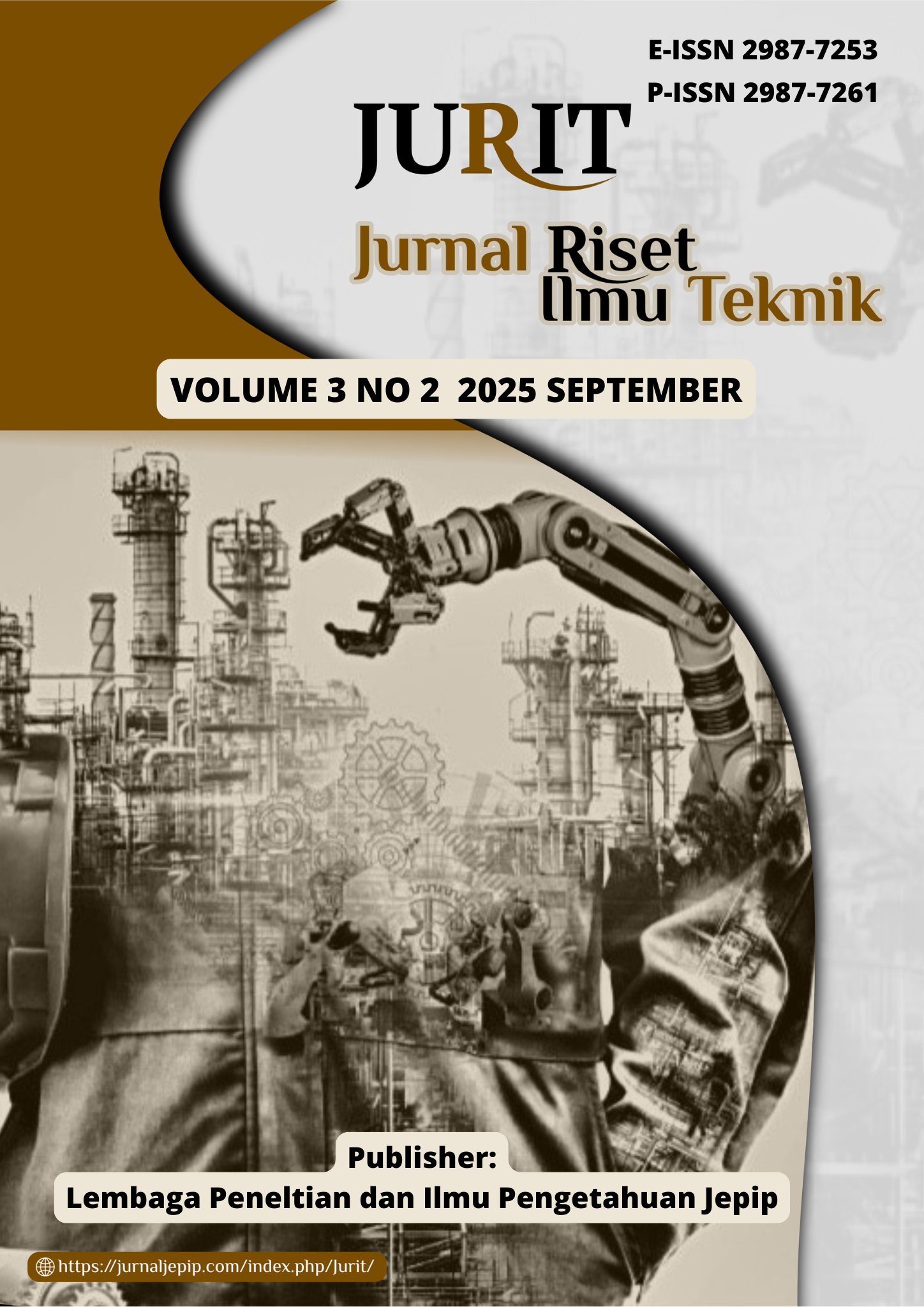A Hybrid Exponential Smoothing–DRP– Framework for Sustainable Distribution Optimization in a Traditional Food Rengginang
DOI:
https://doi.org/10.59976/jurit.v3i2.204Abstract
Purpose: Distribution Requirement Planning (DRP), and route optimization using the Saving Matrix method. The goal is to enhance inventory accuracy, minimize logistics costs, and improve delivery efficiency under fluctuating market demand. Methodology: A quantitative–descriptive analysis was conducted using primary data (field observation and interviews) and secondary data (production and sales records). Weekly demand forecasting was performed using the Exponential Smoothing method with α = 0.9, evaluated through Mean Absolute Deviation (MAD), Mean Squared Error (MSE), and Mean Absolute Percentage Error (MAPE). The DRP model was used to determine gross and net requirements, while the Saving Matrix method was applied to design optimal delivery routes. Findings: The Exponential Smoothing model achieved a high predictive accuracy (MAPE = 10.33%), showing reliable short-term forecasting for MSMEs. DRP implementation with a one-week lead time and a 168-unit safety stock successfully balanced production capacity and customer demand. Integration of DRP and Saving Matrix resulted in approximately 30% reduction in total logistics cost and significant improvement in stock availability. Compared to 17 related studies (2021–2024), this hybrid model demonstrated superior efficiency and cost stability within traditional food industries. Practical Implications: The results provide MSMEs with a data-driven framework to synchronize production, inventory, and distribution planning, reducing decision-making errors and improving operational sustainability. The proposed model can serve as a replicable reference for traditional food SMEs facing fluctuating demand conditions. Value: The novelty of this study lies in combining Exponential Smoothing forecasting, DRP scheduling, and Saving Matrix routing into a unified optimization framework—rarely applied in Indonesia’s traditional food sectors. This integrative method strengthens both academic insight and managerial practice in MSME supply chain efficiency.
Downloads
References
S. Karimi-Arpanahi, “Incorporating flexibility requirements into distribution system expansion planning studies based on regulatory policies,” Int. J. Electr. Power Energy Syst., vol. 118, 2020, doi: 10.1016/j.ijepes.2019.105769.
Y. Ngatilah, “Inventory Control System Using Distribution Requirement Planning (DRP) (Case Study : Food Company),” 2020. doi: 10.1088/1742-6596/1569/3/032005.
C. Wang, “An Optimal Planning Model for Cyber-physical Active Distribution System Considering the Reliability Requirements,” 2022. doi: 10.1109/SPIES55999.2022.10082691.
W. Q. Lee, “Implementing Distribution Requirement Planning and Scheduling System for Lens Manufacturing Company,” 2022. doi: 10.1109/IEEM55944.2022.9989590.
J. A. Uswary, “Wina Sentosa Bottled Water Distribution System Using Web-Based Distribution Requirement Planning and Trend Moment Algorithms,” Adv. Sustain. Sci. Eng. Technol., vol. 6, no. 2, 2024, doi: 10.26877/asset.v6i2.18308.
F. Li, “Bi-level planning for distribution network including distributed generations and electric vehicle charging stations to meet the requirements of internet of things construction,” 2021. doi: 10.1088/1742-6596/2030/1/012089.
J. Han, “Collaborative Planning of Multiple Measures Considering Reliability Improvement Requirements in Distribution System,” 2023. doi: 10.1109/ACEEE58657.2023.10239635.
Z. Zhang, “Research on Optimal Planning Method of Distribution Network Considering Emergency Power Supply Configuration and User Differentiated Reliability Requirements,” 2021. doi: 10.1088/1755-1315/645/1/012020.
Y. Liu, “Planning Method of Distribution Network for End-users Differentiated Reliability Requirements,” 2022. doi: 10.1049/icp.2022.2204.
T. Lin, “Optimisation Method of Distribution Network Planning and Construction Investment Analysis Considering the Substation Requirement,” 2024. doi: 10.1109/ITNEC60942.2024.10733185.
W. Q. Lee, “Implementing Advanced Distribution Requirement Planning and Scheduling System (DRPS) for Lens Manufacturing Company,” 2024. doi: 10.1109/IEEM62345.2024.10857113.
Y. Sun, “Active Distribution Network Energy Storage Planning Model for Reliability Requirements,” 2024. doi: 10.1109/APET63768.2024.10882672.
A. A. Aziz, “Development of a Multi-Echelon Inventory Control System Using the Least Square, the Fixed Time Period (FTP), and the Distribution Requirement Planning (DRP) Methods for Replenishment Policies and Strategies,” 2021. doi: 10.1145/3468013.3468312.
M. McGranaghan, “DISTRIBUTION PLANNING MODEL REQUIREMENTS FOR SMART COMMUNITY INTEGRATION,” 2023. doi: 10.1049/icp.2023.0549.
A. P. Hidayat, “Distribution requirement planning for feed based on SMADISPRO software development,” 2024. doi: 10.1051/e3sconf/202457703001.
X. Xu, “A novel and dynamic land use/cover change research framework based on an improved PLUS model and a fuzzy multiobjective programming model,” Ecol. Inform., vol. 80, 2024, doi: 10.1016/j.ecoinf.2024.102460.
X. Fu, “Agri-Energy-Environment Synergy-Based Distributed Energy Planning in Rural Areas,” IEEE Trans. Smart Grid, vol. 15, no. 4, pp. 3722–3738, 2024, doi: 10.1109/TSG.2024.3364182.
J. Liu, “Prediction of land use for the next 30 years using the PLUS model’s multi-scenario simulation in Guizhou Province, China,” Sci. Rep., vol. 14, no. 1, 2024, doi: 10.1038/s41598-024-64014-7.
L. Adreani, “Smart City Digital Twin Framework for Real-Time Multi-Data Integration and Wide Public Distribution,” IEEE Access, vol. 12, pp. 76277–76303, 2024, doi: 10.1109/ACCESS.2024.3406795.
S. Li, “Evolution characteristics and multi-scenario prediction of habitat quality in Yulin City based on PLUS and InVEST models,” Sci. Rep., vol. 14, no. 1, 2024, doi: 10.1038/s41598-024-62637-4.
Y. Huang, “Disease Course, Treatments, and Outcomes of Children With Systemic Juvenile Idiopathic Arthritis–Associated Lung Disease,” Arthritis Care Res., vol. 76, no. 3, pp. 328–339, 2024, doi: 10.1002/acr.25234.
J. A. Zwerts, “FSC-certified forest management benefits large mammals compared to non-FSC,” Nature, vol. 628, no. 8008, pp. 563–568, 2024, doi: 10.1038/s41586-024-07257-8.
Q. Li, “Multidimensional measurement of the High-Quality development of city Clusters: Dynamic Evolution, regional differences and trend forecasting–based on the basic connotation of Chinese-style modernization,” Ecol. Indic., vol. 161, 2024, doi: 10.1016/j.ecolind.2024.111989.
J. O. Hanson, “Systematic conservation prioritization with the prioritizr R package,” Conserv. Biol., vol. 39, no. 1, 2025, doi: 10.1111/cobi.14376.
A. Inaolaji, “Optimal allocation of battery energy storage systems for peak shaving and reliability enhancement in distribution systems,” J. Energy Storage, vol. 95, 2024, doi: 10.1016/j.est.2024.112305.
M. A. Khan, “Investigation and analysis of demand response approaches, bottlenecks, and future potential capabilities for IoT-enabled smart grid,” 2024. doi: 10.1049/rpg2.13011.
B. Sarkar, “Sustainable multi-biofuel production with stochastic lead time and optimum energy utilization under flexible manufacturing,” Comput. Ind. Eng., vol. 193, 2024, doi: 10.1016/j.cie.2024.110223.
X. Li, “Urban biodiversity conservation: A framework for ecological network construction and priority areas identification considering habit differences within species,” J. Environ. Manage., vol. 365, 2024, doi: 10.1016/j.jenvman.2024.121512.
D. Chen, “Spatial zoning to enhance ecosystem service co-benefits for sustainable land-use management in the Yangtze River economic Belt, China,” Ecol. Indic., vol. 159, 2024, doi: 10.1016/j.ecolind.2024.111753.
J. Huang, “Green supply chain management: a renewable energy planning and dynamic inventory operations for perishable products,” Int. J. Prod. Res., vol. 62, no. 24, pp. 8924–8951, 2024, doi: 10.1080/00207543.2023.2220047.
M. S. Habib, “Developing sustainable, resilient, and responsive biofuel production and distribution management system: A neutrosophic fuzzy optimization approach based on artificial intelligence and geographic information systems,” Appl. Energy, vol. 372, 2024, doi: 10.1016/j.apenergy.2024.123683.
H. Li, “Small Target Detection in Remote Sensing Images Based on Global Context Information,” Guangxue Xuebao Acta Opt. Sin., vol. 44, no. 24, 2024, doi: 10.3788/AOS240606.
L. Wu, “User Side Resource Application and Key Technologies for Flexibility Demand of Renewable Energy Power System,” Dianwang Jishu Power Syst. Technol., vol. 48, no. 4, pp. 1435–1444, 2024, doi: 10.13335/j.1000-3673.pst.2023.0199.
J. Zhu, “Dynamic collaborative optimization for disaster relief supply chains under information ambiguity,” Ann. Oper. Res., vol. 335, no. 3, pp. 1303–1329, 2024, doi: 10.1007/s10479-022-04758-5.
P. Bao, “Efficient virtual power plant management strategy and Leontief-game pricing mechanism towards real-time economic dispatch support: A case study of large-scale 5G base stations,” Appl. Energy, vol. 358, 2024, doi: 10.1016/j.apenergy.2024.122650.
A. Kapoor, “Optimal Planning of Fast EV Charging Stations in a Coupled Transportation and Electrical Power Distribution Network,” IEEE Trans. Autom. Sci. Eng., vol. 21, no. 3, pp. 4261–4271, 2024, doi: 10.1109/TASE.2023.3293955.
C. Dang, “IWRAM: A hybrid model for irrigation water demand forecasting to quantify the impacts of climate change,” Agric. Water Manag., vol. 291, 2024, doi: 10.1016/j.agwat.2023.108643.
G. Alves-Ferreira, “‘phyloraster’’: an R package to calculate measures of endemism and evolutionary diversity for rasters,’” Ecography (Cop.)., vol. 2024, no. 4, 2024, doi: 10.1111/ecog.06902.
Q. Liu, “Optimal operation of coordinated multi-carrier energy hubs for integrated electricity and gas networks,” Energy, vol. 288, 2024, doi: 10.1016/j.energy.2023.129800.
W. Dong, “Enhanced integrated energy system planning through unified model coupling multiple energy and carbon emission flows,” Energy, vol. 307, 2024, doi: 10.1016/j.energy.2024.132799.
Y. Zhou, “Multi-period urban hydrogen refueling stations site selection and capacity planning with many-objective optimization for hydrogen supply chain,” Int. J. Hydrogen Energy, vol. 79, pp. 1427–1441, 2024, doi: 10.1016/j.ijhydene.2024.07.067.
L. Zhang, “PMP method with a cooperative optimization algorithm considering speed planning and energy management for fuel cell vehicles,” Int. J. Hydrogen Energy, vol. 79, pp. 434–447, 2024, doi: 10.1016/j.ijhydene.2024.06.297.
Downloads
Published
How to Cite
Issue
Section
License
Copyright (c) 2025 Qurratu Ainun, Ferry Irawan Sutisna, Leny Andini, Irma Kinari

This work is licensed under a Creative Commons Attribution 4.0 International License.

















